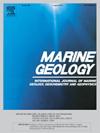Suspended sediment pattern along the Mekong Delta's west coast induced by strong southwest monsoon activities and extreme events
IF 2.2
3区 地球科学
Q2 GEOSCIENCES, MULTIDISCIPLINARY
引用次数: 0
Abstract
Coastal suspended sediment dynamics and distributions are driven by complex forces and factors mainly related to wind-wave, currents and tide actions which resuspend unconsolidated sediment in the water-seabed layer and/or rework sediment in the seabed. Understanding the suspended sediment dynamics and their time- and space distribution are prominent issues for better understanding sediment transport processes, and morphological changes. Reliable estimated values of suspended sediment concentration (SSC) are key values for reliable modeling of coastal sediment transport. This study aims to investigate the spatial-temporal distribution of SSC along the west coast of the Vietnamese Mekong Delta forced by tides, currents and wind-wave factors which were generated during a strong activity of the southwest monsoon and extreme conditions caused by a tropical depression/storm circulation and thunderstorms. Our results showed that coastal currents and wind-wave actions mainly drove the SSC distributions. During the 12-day field survey, a high-turbidity front existed parallel and close to the coast at an average distance of 5 km where water depths range from 2 to 5 m. This front was likely related to the longshore drift current system which was partly captured by field survey data. The mean SSC value over an area of 400 km2 was 80 mg/l, much larger than the values reported in numerical simulations or measurements elsewhere along the subaqueous Mekong Delta. This led to a requirement for reassessment and reanalysis of coastal sediment dynamics based on numerical models and this dataset will serve as an important benchmark for improving the performance of numerical models.
强烈西南季风活动和极端事件诱发的湄公河三角洲西海岸悬沙格局
沿海悬沙的动力和分布是由复杂的力和因素驱动的,这些力和因素主要与风浪、海流和潮汐作用有关,这些作用使水-海底层中的松散泥沙重悬起来,或使海底的泥沙重悬起来。了解悬沙动力学及其时空分布是更好地理解泥沙运移过程和形态变化的重要问题。悬沙浓度(SSC)的可靠估计值是建立可靠的海岸输沙模型的关键。本文研究了西南季候风强活动和热带低气压/风暴环流、雷暴等极端条件对越南湄公河三角洲西海岸南中国海温度的时空影响。研究结果表明,海流和风浪作用主要驱动了南海温的分布。在12天的野外调查中,一个高浊度锋平行并靠近海岸,平均距离为5 km,水深为2 ~ 5 m。这一锋面可能与近海流流系统有关,这一系统已被野外调查资料部分捕获。400平方公里面积上的平均SSC值为80 mg/l,远远大于数值模拟或湄公河三角洲水下其他地方的测量值。这导致了对基于数值模型的海岸沉积物动力学重新评估和再分析的需求,该数据集将作为改进数值模型性能的重要基准。
本文章由计算机程序翻译,如有差异,请以英文原文为准。
求助全文
约1分钟内获得全文
求助全文
来源期刊

Marine Geology
地学-地球科学综合
CiteScore
6.10
自引率
6.90%
发文量
175
审稿时长
21.9 weeks
期刊介绍:
Marine Geology is the premier international journal on marine geological processes in the broadest sense. We seek papers that are comprehensive, interdisciplinary and synthetic that will be lasting contributions to the field. Although most papers are based on regional studies, they must demonstrate new findings of international significance. We accept papers on subjects as diverse as seafloor hydrothermal systems, beach dynamics, early diagenesis, microbiological studies in sediments, palaeoclimate studies and geophysical studies of the seabed. We encourage papers that address emerging new fields, for example the influence of anthropogenic processes on coastal/marine geology and coastal/marine geoarchaeology. We insist that the papers are concerned with the marine realm and that they deal with geology: with rocks, sediments, and physical and chemical processes affecting them. Papers should address scientific hypotheses: highly descriptive data compilations or papers that deal only with marine management and risk assessment should be submitted to other journals. Papers on laboratory or modelling studies must demonstrate direct relevance to marine processes or deposits. The primary criteria for acceptance of papers is that the science is of high quality, novel, significant, and of broad international interest.
 求助内容:
求助内容: 应助结果提醒方式:
应助结果提醒方式:


